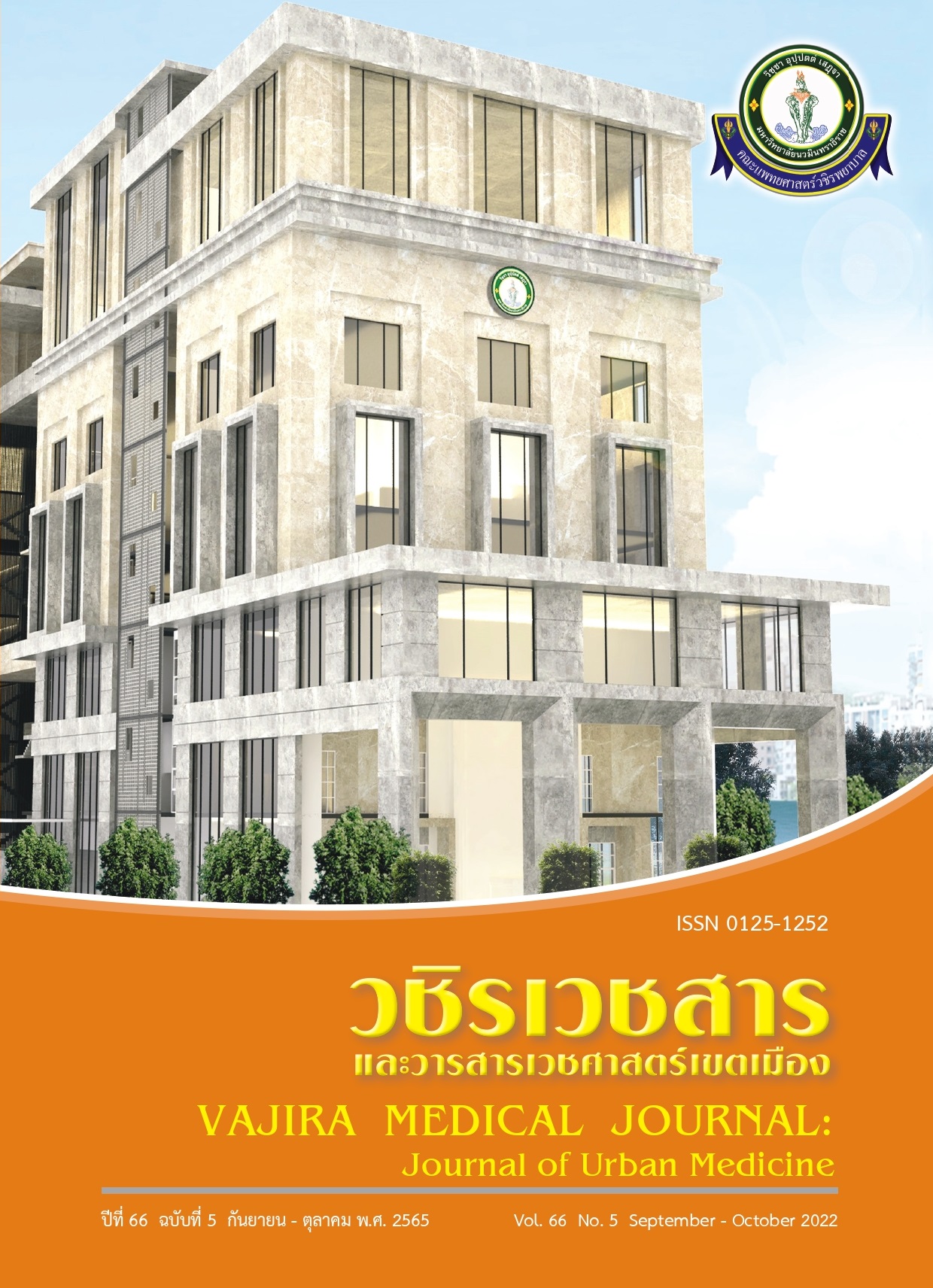Level of Knowledge about “Spit don’t rinse” Brushing Technique and The Affective Factors among Dental Patients in Faculty of Medicine Vajira Hospital, Navamindradhiraj University
Main Article Content
Abstract
Objective: survey the level of knowledge about “spit don’t rinse” brushing technique and study factors
affecting the level of knowledge of “spit don’t rinse” brushing technique of dental patients in Faculty of
Medicine Vajira Hospital, Navamindradhiraj University.
Methods: The cross-sectional survey of 385 dental patients in Faculty of Medicine Vajira Hospital,
Navamindradhiraj. The level of knowledge of “spit don’t rinse” brushing technique and factors were collected
using an online questionnaire created by the researchers. Frequency, percentage, mean and standard deviation
were calculated and compared the level of knowledge about “spit don’t rinse” brushing technique among the
different groups by using Chi-squared test statistics. Multiple logistic regression analysis statistics were used
to analyze relationship between factors and the level of knowledge about “spit don’t rinse” brushing technique.
Results: Overall mean knowledge score of 5.3 ± 2.73. The results showed that 76.6% of dental patients had
low level of knowledge about “spit don’t rinse” brushing technique. Comparisons made between different sex,
age, education, occupation and the experience learning brushing technique “spit don’t rinse” were statistically
significant in level of knowledge. After the multiple logistic regression analysis, the following factors were
moderate/high level of knowledge about “spit don’t rinse” brushing technique: higher bachelor education level
(Adjusted OR = 8.87, 95%CI: 1.66 - 46.40, p-value = 0.011) and the experience learning about “spit don’t rinse”
brushing technique (Adjusted OR = 3.56, 95%CI: 1.22 - 10.37, p-value = 0.020).
Conclusion: The dental patients in Faculty of Medicine Vajira Hospital, Navamindradhiraj University
do not understand and follow the correct procedures of “spit don’t rinse” brushing technique. Dental
practitioners should be able to provide “spit don’t rinse” brushing technique knowledge effectively to
prevent dental caries and promote oral health, which will reduce the prevalence of dental caries in Bangkok.
Downloads
Article Details

This work is licensed under a Creative Commons Attribution-NonCommercial-NoDerivatives 4.0 International License.
References
Thailand BoDH. Report on the eighth national oral health survey of Thailand 2017. Nonthaburi: Department of Health, Ministry of Public Health; 2018.
FDI World Dental Federation. The challenge of oral disease – a call for global action. The oral health atlas. Geneva: FDI world Dental Federation; 2015.
Marinho VC, Higgins JP, Sheiham A, Logan S. Fluoride toothpastes for preventing dental caries in children and adolescents. Cochrane Database Syst Rev 2003(1):CD002278.
Walsh T, Worthington HV, Glenny AM, Marinho VC, Jeroncic A. Fluoride toothpastes of different concentrations for preventing dental caries. Cochrane Database Syst Rev 2019;3:CD007868.
Department of Health, NHS, BASCD. Delivering better oral health: an evidence-based toolkit for prevention. London: Public Health England; 2014.
Sjogren K, Birkhed D. Effect of various postbrushing activities on salivary fluoride concentration after toothbrushing with a sodium fluoride dentifrice. Caries Res 1994;28(2):127-31.
Ashley PF, Attrill DC, Ellwood RP, Worthington HV, Davies RM. Toothbrushing habits and caries experience. Caries Res 1999;33(5):401-2.
Chesters RK, Huntington E, Burchell CK, Stephen KW. Effect of oral care habits on caries in adolescents. Caries Res 1992;26(4):299-304.
Chestnutt IG, Schafer F, Jacobson AP, Stephen KW. The influence of toothbrushing frequency and post-brushing rinsing on caries experience in a caries clinical trial. Community Dent Oral Epidemiol 1998;26(6):406-11.
Machiulskiene V, Richards A, Nyvad B, Baelum V. Prospective study of the effect of post-brushing rinsing behaviour on dental caries. Caries Res 2002;36(5):301-7.
O'Mullane DM, Kavanagh D, Ellwood RP, Chesters RK, Schafer F, Huntington E, et al. A three-year clinical trial of a combination of trimetaphosphate and sodium fluoride in silica toothpastes. J Dent Res 1997;76(11):1776-81.
Pitts N, Duckworth RM, Marsh P, Mutti B, Parnell C, Zero D. Post-brushing rinsing for the control of dental caries: exploration of the available evidence to establish what advice we should give our patients. Br Dent J 2012; 212(7):315-20.
Krisdapong S. Split don't rinse. Journal of Health Science 2017;26(6):1148-55.
Daniel WW. Biostatistics: a foundation for analysis in the health sciences. 6th ed. New York: Wiley; 1995. p.780.
Bloom BS, Hastings JT, Madaus GF. Handbook on formative and summative evaluation of student learning. New York: McGraw-Hill; 1971. p.923.
Rovinelli RJ, Hambleton RK. On the use of content specialists in the assessment of criterion-referenced test item validity. Dutch Journal of Educational Research 1977.
Cronbach LJ. Coefficient alpha and the Internal structure of tests. Psychometrika 1951;16:297-334.
Zero DT, Marinho VC, Phantumvanit P. Effective use of self-care fluoride administration in Asia. Adv Dent Res 2012;24(1):16-21.
Elrashid AH, AI-Kadi RK, Baseer MA, Rahman GS, Alsaffan AD, Uppin RB. Correlation of sociodemographic factors and oral health knowledge among residents in Riyadh city. J Oral Health Comm Dent 2018;12(1):8-13.


